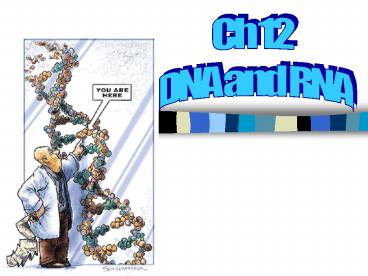Understanding DNA PowerPoint PPT Presentation
1 / 32
Title: Understanding DNA
1
Ch 12 DNA and RNA
2
What is DNA?
- DNA (deoxyribonucleic acid)- a nucleic acid which
stores genetic traits in the proteins it codes
for. - All living things contain DNA.
- DNA is a nucleic acid.
- Nucleic acids are made of nucleotide subunits
hooked together.
3
Nucleotides
- Nucleotides- subunits of DNA made of
- 1. Phosphate (PO4)
- 2. Sugar (deoxyribose).
- 3. Nitrogen base.
4
Nitrogen Bases
- Four different nitrogen bases makes four
different nucleotides - Guanine
- Cytosine
- Adenine
- Thymine
- These four nucleotides make up the DNA of almost
every single living thing.
5
(No Transcript)
6
Nucleotides
7
Chargaffs Rule
- He measured amounts of each base in various
organisms and found - of adenine (A) thymine (T)
- of cytosine (C) guanine (G)
- Chargaffs rule told us that A bonds to T and C
bonds to G - If 20 of strand is A, what T? C?
8
Structure of DNA
- Discovered by Watson and Crick
- Double helix- 2 spiral strands of nucleotides
bonded together
9
Structure of DNA
- Siderail backbone is the sugar and phosphates of
nucleotides - Rungs are the nitrogen bases of nucleotides
- A----T
- C----G
- Hydrogen bonds between bases hold two strands
together
10
What is DNA Replication?
- Replicate make exact copies.
- DNA replication- copying of DNA so that a cell
made divide - All DNA must be replicated before a cell can
divide. Why?
11
Enzymes and Replication
- Helicase- enzyme that unwinds DNA
- DNA polymerase-enzyme that moves along each
strand and brings in bases for new strand copy
12
DNA Replication
- Can be a mistake in replication
- Mutations-change in DNA
- Mutagens- substances that cause mutations
- X-rays
- Toxins
- Drugs
- UV light, etc.
13
Mutations
- 3 types of mutations that can occur during DNA
replication - Insertions -extra nucleotides
- Deletions missing nucleotides
- Substitutions placement of wrong nucleotides
- Can be helpful or harmful
- mutations.
Insertion
Deletion
Substitution
14
Most Destructive Mutation?
- The bases, A, C, G, and T can be equated to
letters of a DNA sentence - THE DOG WAS HOT IN THE SUN
- Substitution
- THE DOG WAS NOT IN THE SUN
- Insertion?
- THE DOG NWA SHO TIN THE SUN
- Deletion?
- THE DOG ASH OTI NTH ESU N
- Why should I care?
15
How Much DNA Is In OUR Cells?
- Chromosome-strands of DNA coiled tightly
- Human cell has 46 (23 pairs)
- 23 from Mom
- 23 from Dad
- Other organisms
- have different
- numbers of
- chromosomes
16
2 Types of Cells
- Somatic cells all body cells except sex cells
- Diploid?chromosomes are in pairs
- 4623 pairs for humans
- 1 set (23) from mom, 1 set (23) from dad
- Gametes - sex cells
- Egg sperm
- Haploid ?no pairs (only 23 single chromosomes)
17
Human Chromosomes
- If all body cells contain the same of
chromosomes, why are all cells so different? - Different cells make different proteins due to
different active segments of DNA. - Heart cells make proteins needed for the heart to
work properly - Brain cells make proteins needed for the brain to
work properly
18
What is the Purpose of DNA?
- DNA stores the genetic information that codes for
proteins. - ALL CELL FACTORIES MAKE PROTEINS!
19
What is the Purpose of DNA?
- Gene- a segment of DNA that codes for a protein.
- DNA has 1000s of genes to make many different
types of proteins. - Why are proteins important?
- Protein - polymer of amino acids
- aaaaaaaaaaaaaaaa protein
20
What is the Purpose of DNA?
21
RNA (Ribonucleic acid)
_____DNA____ vs._____RNA___
- Stores the genetic code in the nucleus
- Double stranded
- Sugar of DNA nucleotides deoxyribose
- A, C, G, T
- DNA is DNA
- Found in nucleus only
Transmits the genetic code to the rest of the
cell Single stranded Sugar of RNA nucleotides is
ribose A, C, G, U (uracil) NO T! Different
forms mRNA, rRNA, tRNA Found all over cell
22
DNA vs. RNA
23
Part 1of Protein Synthesis Transcription
- Transcription- copying of DNA to mRNA that occurs
in the nucleus. - DNA complementary to mRNA
- ATA-CGG-AAT (DNA)
- transcription in nucleus
- UAU-GCC-UUA (RNA)
24
Transcription
cytoplasm
Translation
25
Part 2 of Protein Synthesis Translation
- Translation- converting mRNA to protein which
occurs at ribosomes in the cytoplasm - mRNA codons
- translation by ribosomes
- a.a.---a.a---a.a (protein)
cytoplasm
26
Part 2 of Protein Synthesis Translation
- Codon-three bases of mRNA that code for an amino
acid - UAU-GCC-UUA (3 mRNA codons)
- translation by ribosomes
- a.a.---a.a---a.a. (protein)
- mRNA needs the help of tRNA to bring in the amino
acids to be hooked together
cytoplasm
27
Whole Process
- ATA-CGG-AAT (DNA)
- transcription in nucleus
- UAU-GCC-UUA (3 mRNA codons)
- translation in cytoplasm at
ribosomes - a.a.-a.a-a.a. (protein)
- How do we know what amino acid results?
- The Codon Wheel!!!
28
Part 1 Transcription
cytoplasm
Part 2 Translation
29
The Codon WheelHow do we use the wheel? There
are 2 clues.
30
The Codon Wheel
31
Whole Process
- DNA ATA-CGG-AAT
- transcription in nucleus
- mRNA UAU-GCC-UUA(3 codons)
- translation in cytoplasm
- protein a.a.-a.a-a.a.
- tyrosine-alanine-leucine
- Protein Synthesis Animation!
- How do we know what amino acid results?
- The Codon Wheel!!!
32
Amino Acids
- Where do our cells get these amino acids to build
the proteins? - From FOOD!
- We eat proteins, then these proteins are broken
down (metabolized) into amino acids in our
stomach. - We reuse these amino acids to build other
proteins.

